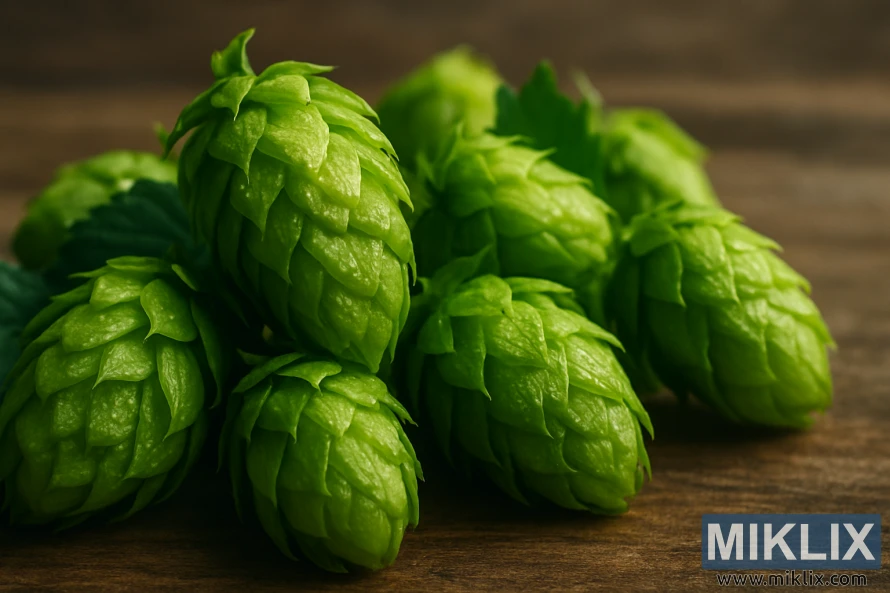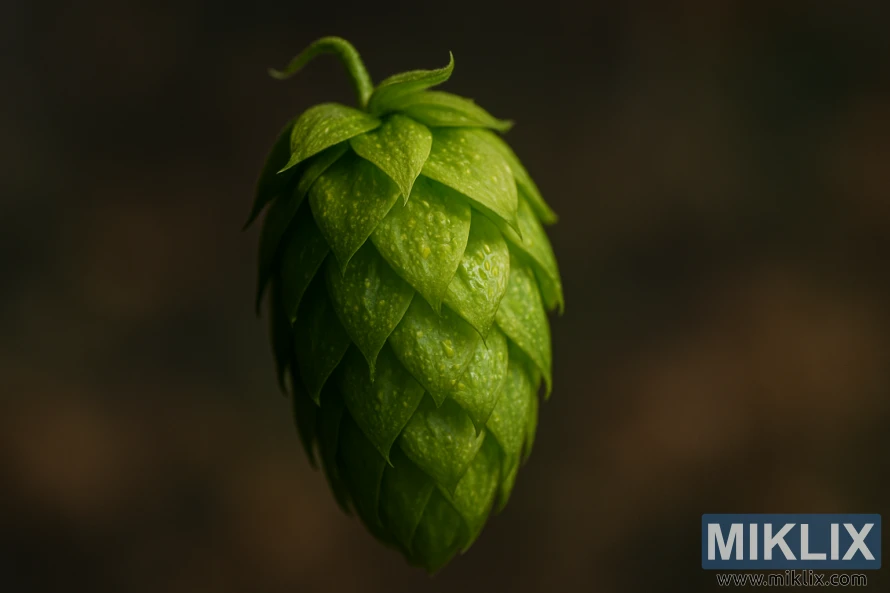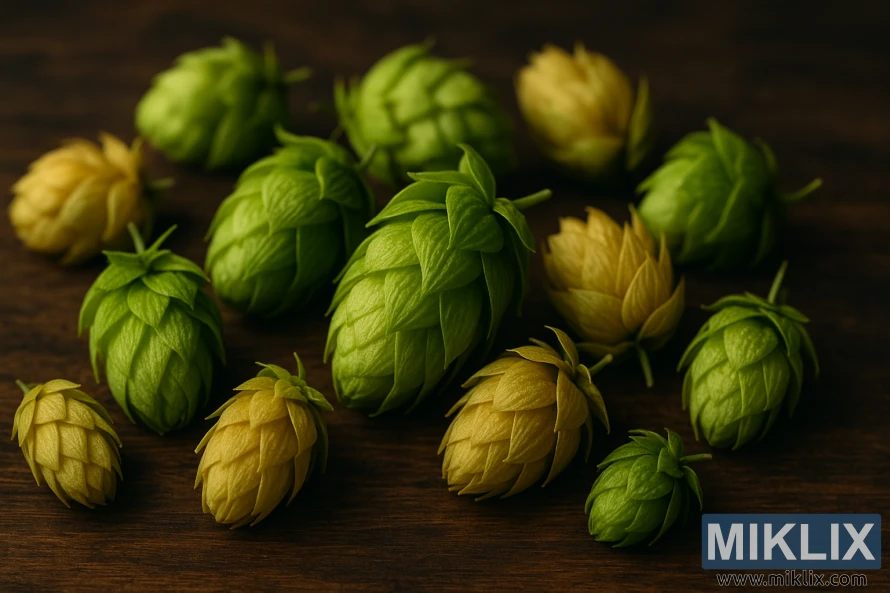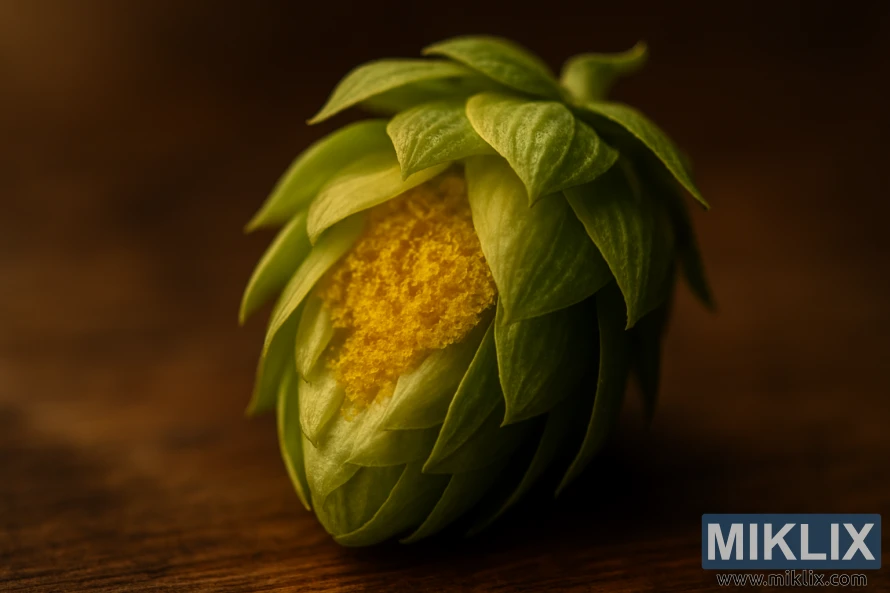Hops in Beer Brewing: Aramis
Published: September 25, 2025 at 7:45:46 PM UTC
Aramis hops, a French variety, were introduced by Hops France and bred at Cophoudal in Alsace. They are a result of crossing Strisselspalt with the Whitbread Golding Variety. First used commercially around 2011, they have shown great promise for aroma-focused recipes. This Aramis hop guide is designed for brewers looking to explore its use in ales. It covers practical brewing, sensory profile, technical values, and sourcing in the United States. It also includes recipe ideas and advanced techniques for those interested in Belgian styles to modern pale ales.

When brewing with Aramis hops, it's best to use them in late-boil additions, whirlpool, and dry hopping. There are no cryo or lupulin powder products available. Brewers will typically work with whole cone or pellet forms from various suppliers and harvest years.
Key Takeaways
- Aramis Hops is a French aroma hop bred from Strisselspalt and WGV, suited for aroma additions.
- Best used late in the boil, in whirlpool, or as a dry hop to highlight floral and spice notes.
- Pairs well with Belgian and lightly esteric yeast strains, and adapts to experimental IPAs.
- No major cryo/lupulin powder versions exist; sourcing varies by supplier and harvest year.
- This Aramis hop guide will cover sensory profile, brewing values, recipes, and U.S. sourcing.
What Are Aramis Hops and Their Origin
Aramis, a modern French hop, originates from Alsace. It is identified by the breeder code P 05-9 and the international identifier ARS cultivar. Hops France owns the variety, developed through regional breeding programs.
Bred at the Cophoudal station in Alsace, Aramis was created in 2002. It resulted from a cross between Strisselspalt and the Whitbread Golding Variety. This cross aimed to enhance aromatic finesse and agronomic resilience in northern Europe.
Commercial use of Aramis began around 2011. This makes it a recent addition to the hop palette. Growers in France are expanding their varieties, with Aramis being one of the new releases. It is intended for both domestic and export markets.
The variety’s flavor hints and floral-terpenic profile suggest a good match with Belgian-style yeast accents. Brewers seeking innovative aroma options may find Aramis complements fermentation-driven esters well.
- Origin: France, Alsace region
- Breeding: cross of Strisselspalt × Whitbread Golding Variety
- ID: P 05-9, ARS cultivar
- First commercial use: circa 2011
Flavor and Aroma Profile for Aroma-Focused Brewing
Aramis offers a distinct spicy herbal citrus hop character. It is best treated with care. The aroma profile is often described as green and herbal, with black pepper notes and a light floral touch.
When tasting, Aramis reveals subtle citrus and lemongrass notes. These are set against a backdrop of earthy, woody, and grassy flavors. Some pours also bring a tea-like, almost bergamot quality, which complements delicate yeast esters.
For those focusing on aroma, late additions, whirlpool rests, and dry hopping are key. These methods help preserve volatile oils and emphasize the hop's sweet-spicy essence. It's important to use small, targeted additions to avoid overwhelming the beer's malt or yeast character.
Aramis pairs beautifully with Belgian or farmhouse yeasts. Here, phenols and fruity esters blend with the hop's character. Brewers find that in such beers, Aramis tasting reveals a complex spice profile, faint citrus, and gentle floral notes. These evolve over time, adding depth to the brew.
- Primary traits: spicy, herbal, citrus
- Secondary traits: grassy, floral, woody, earthy
- Recommended use: late addition, whirlpool, dry hop

Brewing Values and Alpha/Beta Acid Details
Aramis offers a moderate alpha acid range, appealing to brewers seeking versatility. Alpha acids typically range from 5.5–8.5%, averaging around 7%. Some batches have reached higher levels, up to 7.9–8.3%, influenced by seasonal changes and growing conditions.
Beta acid values are generally lower, ranging from 3–5.5%, with an average of 4.3%. This balance results in an alpha-beta ratio of 1:1 to 3:1, averaging 2:1. This ratio allows Aramis to contribute measured bitterness while excelling in aroma work.
The cohumulone content of alpha acids is significant, ranging from 20–42%, with an average of 31%. This percentage impacts the bitterness quality and should be considered when calculating bittering additions in the kettle.
Total oil content is modest, ranging from 1.2–1.6 mL per 100 g, averaging 1.4 mL. This oil content significantly enhances the aroma when used in late additions and dry hopping.
- Myrcene averages 38–41% of the oil, supplying resinous, citrus, and fruity notes.
- Humulene is about 19–22%, adding woody and spicy nuances.
- Caryophyllene runs 2–8%, contributing peppery and herbal facets.
- Farnesene sits near 2–4%, giving fresh, green, floral touches.
- Other oils, including β-pinene, linalool, and geraniol, make up roughly 25–39% of the profile.
Understanding ARS hop chemistry reveals why Aramis excels as an aroma hop. The blend of terpenes and sesquiterpenes creates a complex scent. This enhances late additions and dry-hop aroma without dominating malt or yeast flavors.
For brewers, consider Aramis as an aroma-forward variety with moderate bittering capabilities. Use its alpha and beta acid numbers for accurate IBUs. Rely on Aramis oil content and ARS hop chemistry to shape the final aroma and flavor.
How to Use Aramis Hops in the Brewday
Plan Aramis hop additions to protect volatile oils. Total oils in Aramis are fragile. Add most of the hops late in the boil, in the whirlpool, or as an Aramis dry hop to preserve floral and citrus notes.
For kettle timing, use Aramis in the last 5–0 minutes. Short-boil additions keep aroma bright and reduce loss of volatile compounds. You can also use small early additions for light bittering, given the moderate alpha acids.
Whirlpool technique works well with Aramis whirlpool temps near 160–180°F. Hold hops at those temperatures for 10–30 minutes to extract aroma without driving off oils. This method gives fuller flavor than boiling and better clarity than cold additions.
Dry hopping delivers the strongest scent impact. Add Aramis dry hop either during active fermentation or post-fermentation. Fermentation-stage dry hopping can blend biotransformation effects, while post-fermentation preserves delicate top notes.
No lupulin concentrates exist for Aramis, so account for pellet or whole-cone strength when scaling recipes. Use slightly higher weights compared with lupulin powder to match aromatic intensity.
- Late-kettle: 5–0 minutes for bright top notes.
- Whirlpool: 160–180°F for 10–30 minutes to maximize aroma without harshness.
- Dry hop: during or after fermentation for dominant fragrance.
Experiment with split additions to balance aroma and flavor. Combine a small late-boil dose with an Aramis whirlpool addition and finish with an Aramis dry hop for persistent aroma layers.
Record quantities and timing when testing new formulas. Small changes in contact time or temperature shift the hop character noticeably, so keep notes for repeatable results.

Aramis Hops in Specific Beer Styles
Aramis is a natural fit for Belgian styles. Its herbal and floral notes complement the spicy and fruity elements of saisons and Belgian ales. Use it in moderation, adding it late in the boil or in the whirlpool to enhance aromas without overpowering yeast flavors.
In saisons, Aramis adds a subtle citrus and savory complexity. Balance bitterness and let yeast-driven peppery notes shine. Dry hopping with small amounts can boost top notes while preserving the beer's rustic character.
Belgian Tripels and other big Belgian ales benefit from a light touch of Aramis. Use it sparingly, focusing on late additions and short whirlpool rests. Avoid heavy late hopping to preserve the complex malt and yeast interaction.
Aramis can also enhance pale ales and IPAs when used thoughtfully. Blend it with citrus-forward hops like Citra or Amarillo in small ratios to avoid clashing. Aim to add floral-herbal layers without overpowering the beer.
Lagers and pilsners require a delicate touch. A light addition of Aramis can add herbal depth to clean malt profiles. Use minimal late hopping to maintain crispness and mouthfeel.
Dark styles like porters or brown ales benefit from a restrained use of Aramis, adding foresty depth. In bready or wheat beers like Weizenbier, tiny doses can complement clove and banana esters without overwhelming them.
- Use Aramis to complement saison/Belgian yeast profiles.
- In IPAs, pair Aramis sparingly with citrus hops.
- For lagers and pilsners, apply very light late additions.
Recipe Ideas and Example Brew Plans
Below are compact recipe concepts and a practical Aramis brew plan for home and pro brewers. Each idea lists hop timing, rough rates, and expected flavor lift. Use these as templates for saisons, Belgian styles, and pale ales.
Saison concept: Base of Pilsner malt with 10% wheat and light Munich. Use Saison yeast with moderate attenuation. Add Aramis in the whirlpool at 170°F for 20–30 minutes, then apply an Aramis dry hop schedule of 5–10 g/L for three to five days to emphasize herbal and citrus top notes.
Belgian Tripel concept: Pale malt-focused grist to let yeast drive esters. Keep hop additions late in the kettle and limit dry hopping. A modest Aramis hop recipes approach uses small late kettle additions and a minimal dry hop to add lemongrass nuance without masking the yeast character.
Pale Ale / Session IPA concept: Balanced pale malt bill with a touch of crystal for body. Use Aramis late additions at 5 minutes and a blended dry hop with Willamette or Ahtanum to create an earthy, spicy-citrus combo. Follow a straightforward Aramis brew plan: 5 g/L late hop plus 4–8 g/L blended dry hop depending on desired intensity.
- Whirlpool tip: 20–30 minutes at 160–175°F brings out herbal & citrus oils.
- Dry hop timing: Add after primary fermentation slows, rest 3–5 days for clarity and aroma lift.
- Sizing: Aramis total oil ~1.4 mL/100g, so expect to use higher inclusion rates than more concentrated aroma hops.
Practical rates: For aroma-focused beers target 5.5–8.5% alpha acids in the recipe math and plan hop weights appropriately. Because no lupulin concentrate exists for Aramis, increase pellet weight for bold aroma. Adjust the Aramis dry hop schedule and whirlpool doses to reach the aromatic profile you want.
Quick example quantities for a 5-gallon batch: Saison: 40–60 g whirlpool + 80–120 g dry hop. Tripel: 20–40 g late kettle + 20–40 g dry hop. Pale Ale: 30–50 g late + 60–100 g blended dry hop. Use these ranges as starting points and fine-tune by aroma and alpha targets when you draft your own Aramis hop recipes.
Pairing Aramis Hops with Malts and Yeasts
Aramis hops shine when the malt bill is light, allowing their herbal, spicy, citrus, and woody notes to stand out. Start with a pilsner or pale malt base to keep the flavor bright. Adding Vienna or light Munich malts brings a biscuit-like quality without overpowering the hops.
For a richer mouthfeel, incorporate small amounts of wheat or oats. These malts enhance the body in saisons and other farmhouse ales, while maintaining compatibility with lighter malt bases.
Yeast selection is critical. Belgian saison and classic Trappist strains enhance esters and phenols, complementing Aramis's unique character. This combination creates a spicy, peppery profile with lemony top notes.
For a cleaner showcase, choose neutral American ale yeasts. They allow the herbal and citrus aspects of Aramis to shine. Clean ale and lager yeasts are ideal when the hops are the main focus, not yeast-driven complexity.
- Example 1: Saison yeast plus pilsner and a touch of wheat for body enhances spicy and lemongrass notes with Aramis dry-hop.
- Example 2: American ale yeast with pale malt highlights herbal and citrus traits for a bright, drinkable ale.
- Example 3: Vienna/Light Munich malt base with Trappist yeast creates layered spice and breadiness that pairs well with Aramis malt compatibility goals.
In recipe planning, balance is essential. Use light crystal malts and avoid heavy roast. This approach ensures clarity in hop aroma and supports intentional yeast pairings to achieve the desired flavor focus.
Substitutions and Comparable Hop Varieties
Experienced brewers often seek out multiple options when Aramis is not available. Good single-hop swaps include Willamette, Challenger, Ahtanum, Centennial, Strisselspalt, East Kent Goldings, US Saaz, and Hallertau Mittelfrüh. Each offers a unique balance of spice, herbal tones, or bright citrus to the beer.
When selecting substitutes, consider the flavor profile you aim to achieve. For a noble, earthy, floral character, try Strisselspalt alternatives like East Kent Goldings or Hallertau Mittelfrüh. For herbal and rounded earthiness, a Willamette substitute such as Challenger or Willamette itself will fit well.
To enhance citric or fruity notes, select Ahtanum or Centennial. These hops share some similarities with Aramis but lean more towards grapefruit and orange peel. Blending these with milder noble varieties can help maintain balance while adding brightness to an Aramis-style profile.
Adjust the rates of your hops to match their oil content and alpha acid levels. Aramis averages about 7% alpha, so scale bittering additions when using a hop with higher or lower alpha. For late additions and dry hops, increase or decrease grams per liter to achieve comparable aroma intensity.
The unique spicy, herbal, lemongrass, and tea-like mix of Aramis can be challenging to replicate with a single variety. Many brewers create closer matches by blending two or three substitutes. A Willamette substitute paired with Ahtanum or Centennial often comes closest to the original complexity.
Use this list as a starting point and taste as you go. Small test boils or split batches help dial in substitution rates and blends. Keep notes on extraction, timing, and perceived aromas to refine future swaps.

Availability, Purchasing and Sourcing in the United States
Aramis hops are available through specialty hop retailers, craft brew supply shops, and online marketplaces. When looking to buy Aramis hops, check for both pellet and whole-cone forms. Also, verify if the vendor provides information on the harvest year.
The availability of Aramis hops can fluctuate with the seasons. This French-bred variety, while new to the market, is not as widely grown in the United States as Cascade or Citra. Expect shipments from European importers and select Aramis suppliers who stock continental varieties.
Ensure the packaging indicates vacuum-sealed or frozen storage. Freshness is key for maintaining aroma. Confirm the harvest year and storage method before making a purchase. Some sellers on Amazon and smaller hop stores may carry limited lots. In contrast, larger distributors often offer more consistent supplies.
- Search specialty hop retailers for pellet and whole-cone Aramis.
- Check craft brew shops and online marketplaces to buy Aramis hops in small quantities.
- Contact Aramis suppliers early to reserve stock if planning a large brew.
Aramis is not available as lupulin powder from major processors like Yakima Chief Hops, BarthHaas, or Hopsteiner. Domestic production is limited, leading to varying lead times and prices based on vendor and harvest year.
When sourcing in the US, consider ordering from importers who regularly bring in European hop varieties. This approach increases the chances of finding recent harvests and a better selection of Aramis hops in the USA.
Sensory Evaluation and Tasting Notes for Brewers
Begin by conducting small side-by-side tastings. Prepare a control batch without Aramis and another with a specific amount added. Use Strisselspalt or Willamette as reference hops to better understand Aramis.
Create a simple score sheet to rate the beer. Assess aroma intensity, spiciness, citrus clarity, herbal lift, and any vegetal or grassy off-notes. Note the temperature, hop form, and timing of additions for more detailed Aramis tasting notes later.
- Aroma: look for floral and subtle citrus top notes that sit above herbal tones.
- Flavor: note black pepper, lemongrass, and tea-like (Earl Grey) qualities when present.
- Texture: evaluate mouthfeel and how hop compounds interact with yeast esters and phenols.
When evaluating Aramis hops, focus on how the spice and herbal cues integrate with the beer. In saisons, expect lively herbal and peppery top notes that play with yeast-derived phenols.
For pale ales and IPAs, evaluate Aramis hops for a spicier, earthier citrus presence. This is different from bright tropical fruit. Track any grassy or hay-like characters that signal overuse.
In lagers, use Aramis sparingly. A light floral or herbal lift works best in delicate lager profiles. Note any vegetal notes that may appear if additions are too heavy or late.
- Smell first, then sip. Hold aroma notes in memory before tasting.
- Compare control and Aramis samples for contrast in spice and citrus clarity.
- Write concise Aramis sensory notes: describe intensity, specific markers, and perceived balance.
Repeat trials with varied rates and timing to build a reliable sensory picture. Clear, consistent notes help brewers refine recipes and make confident adjustments based on Aramis tasting notes.

Common Mistakes and Troubleshooting with Aramis
Aramis oils are volatile. Adding Aramis too early in the boil strips aroma. Brewers who use large early kettle additions often end up with bitter beer and weak hop character. If bitterness is the goal, keep those early additions small and intentional.
Under-dosing is frequent. There is no lupulin powder version of Aramis, so relying on powdered substitutes will yield lower aroma intensity. For vibrant profiles, boost late additions, whirlpool hops, or dry-hop rates.
- Overuse in bittering wastes aromatic potency and can create sharp, astringent notes.
- Underuse compared to lupulin products gives disappointing aroma intensity.
- Pairing with yeast strains that produce strong phenols or esters can mask subtle hop nuances.
When vegetal or grassy flavors appear, reduce hop quantity and shorten contact time. Those off-notes often come from prolonged dry-hop contact or excessive whole-cone material. Adjust timing to favor clean citrus and spice over green flavors.
If bitterness feels harsh, inspect cohumulone levels in your blend and cut back on early additions. Blending Aramis with lower-cohumulone varieties like Cascade or Citra can smooth bitterness while preserving character.
- Muted aroma: increase late/whirlpool/dry-hop rates or lengthen dry-hop contact by a few days.
- Grassy/vegetal notes: lower quantities and shorten contact time; consider cold conditioning before packaging.
- Sharp bitterness: reduce early kettle additions or blend with hops lower in cohumulone.
For targeted troubleshooting Aramis, log each change. Track addition times, hop weights, contact duration, and yeast strain. Small, controlled trials reveal which variable caused Aramis hop problems.
Keep recipes simple on the first run. That reduces Aramis common mistakes and makes it easier to spot the source of off-flavors. Once you dial in late additions and yeast choice, Aramis rewards with bright, distinctive aroma.
Commercial Examples and Use Cases
Aramis hops have been integrated into a variety of commercial brews. They are used in saisons, Belgian ales, French ales, Trappist-style beers, porters, pale ales, weizenbier, pilsners, and lagers. This versatility highlights Aramis' ability to complement both delicate lagers and robust Belgian-inspired brews.
Baird Brewing, Ishii Brewing, and Stone Brewing joined forces to create a Japanese Green Tea IPA. This beer showcases Aramis' compatibility with adjuncts like tea and botanicals. It adds herbal and spicy notes to modern IPA interpretations, exemplifying innovative commercial use.
Breweries select Aramis for its subtle green tea-like, herbal, or black pepper nuances. It's often used in recipes aiming for balanced bitterness and a pronounced aroma. Craft and regional brewers frequently choose Aramis for beers that feature botanicals or culinary ingredients prominently.
Common applications include:
- Herbal saisons and farmhouse ales that emphasize peppery spice and citrus lift.
- Belgian and French-style ales where noble-like character merges with modern hop expression.
- Experimental collaborations that pair hops with tea, rosemary, or citrus zest.
- Light lagers or pilsners where a subtle herbal top note enhances complexity without overwhelming malt.
When incorporating Aramis into recipes, brewers often add it late in the kettle, whirlpool, or dry-hop stages. This method preserves its aromatic qualities. It allows Aramis to contribute fresh herbal tones while supporting other hop varieties. As more breweries document their Aramis recipes, the range of successful styles and techniques expands.
Advanced Techniques: Dry Hopping, Whirlpool, and Blending
Aramis hops release volatile oils that need gentle handling. Use Aramis whirlpool additions at moderate temperatures to keep those oils intact. Aim for roughly 160–180°F for 15–30 minutes to extract aroma while limiting losses.
Dry hopping can change aroma based on timing. An Aramis dry hop during active fermentation encourages biotransformation with Belgian or farmhouse yeasts. This creates layered, spicy-fruity notes. A post-fermentation Aramis dry hop gives a cleaner hop lift.
Because no cryo or lupulin-only form exists, choose whole-cone or pellet Aramis with care. Use moderate to generous rates to match aroma intensity from concentrated hops. Combining Aramis whirlpool work with a later Aramis dry hop often gives the best depth.
Blending Aramis offers many paths. Pair Aramis with Willamette or Strisselspalt for herbal, noble character. Combine with Ahtanum or Centennial to add citrus lift. Multi-hop blends let you craft complexity or stretch supply when Aramis is limited.
- Whirlpool: 160–180°F for 15–30 minutes to capture oils.
- Active-fermentation dry hop: promotes biotransformation and novel esters.
- Post-fermentation dry hop: preserves straightforward hop aroma.
- Blending Aramis: mix with noble or American hops depending on target profile.
Practical technique tips matter. Add hops in mesh bags or stainless vessels to make removal easy. Monitor contact time; extended exposure can introduce vegetal tones. Taste frequently to dial in the right balance.
Use the Aramis technique to experiment. Try a modest whirlpool addition, a short contact time, then a measured Aramis dry hop during fermentation for a complex, aromatic beer. Track each trial to refine future batches.
Conclusion
This Aramis hop summary encapsulates its origin, flavor, and practical use. Developed in Alsace from a cross of Strisselspalt and WGV, Aramis offers a unique blend of spicy, herbal, and floral notes. It also brings a hint of light citrus and lemongrass, with earthy undertones. Its moderate alpha acids and substantial total oil content make it perfect for late additions, preserving its aromatic essence.
For brewers aiming to incorporate Aramis, focus on whirlpool and dry-hop techniques. Small-batch trials are essential to achieve the right balance. It pairs exceptionally well with Belgian yeasts and light malt bills. Aramis excels in saisons and Belgian styles, adding depth to pale ales and experimental IPAs.
Aramis is accessible to US brewers through specialty suppliers and online marketplaces. It is not available as a lupulin powder concentrate. Plan your sourcing and dosage carefully. Emphasize late additions to capture its distinct spicy, herbal, and citrus notes. Experiment to discover how it enhances your house yeasts and recipes.
Further Reading
If you enjoyed this post, you may also like these suggestions:
